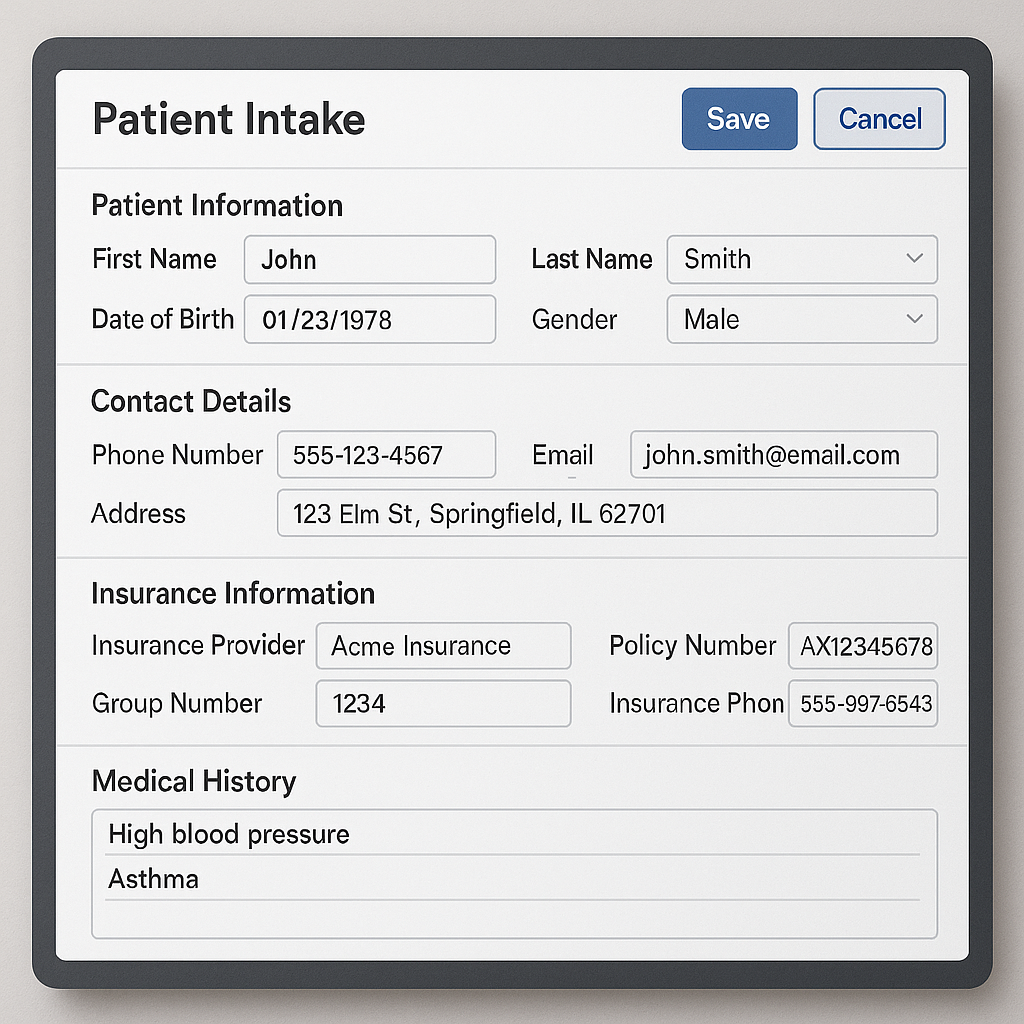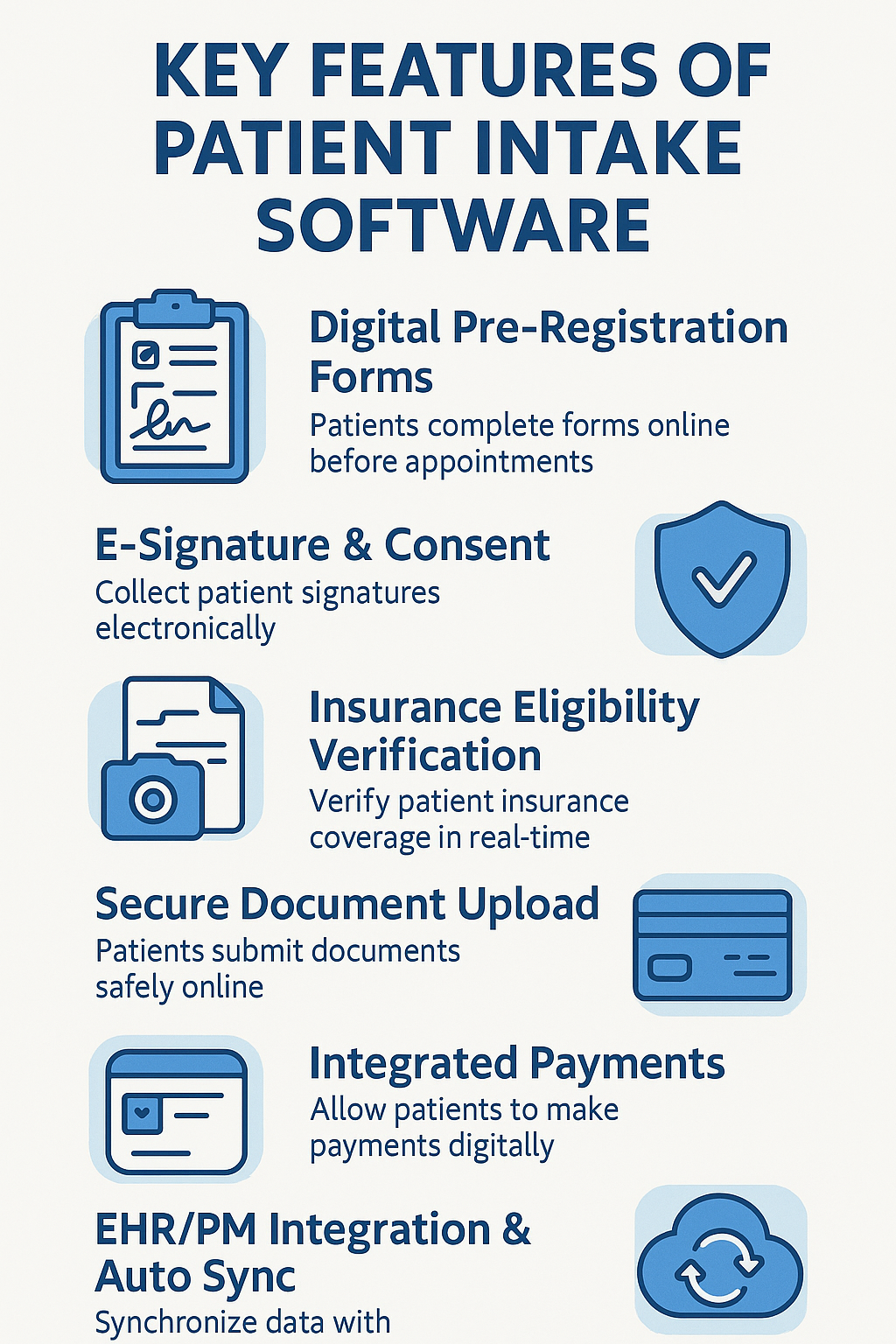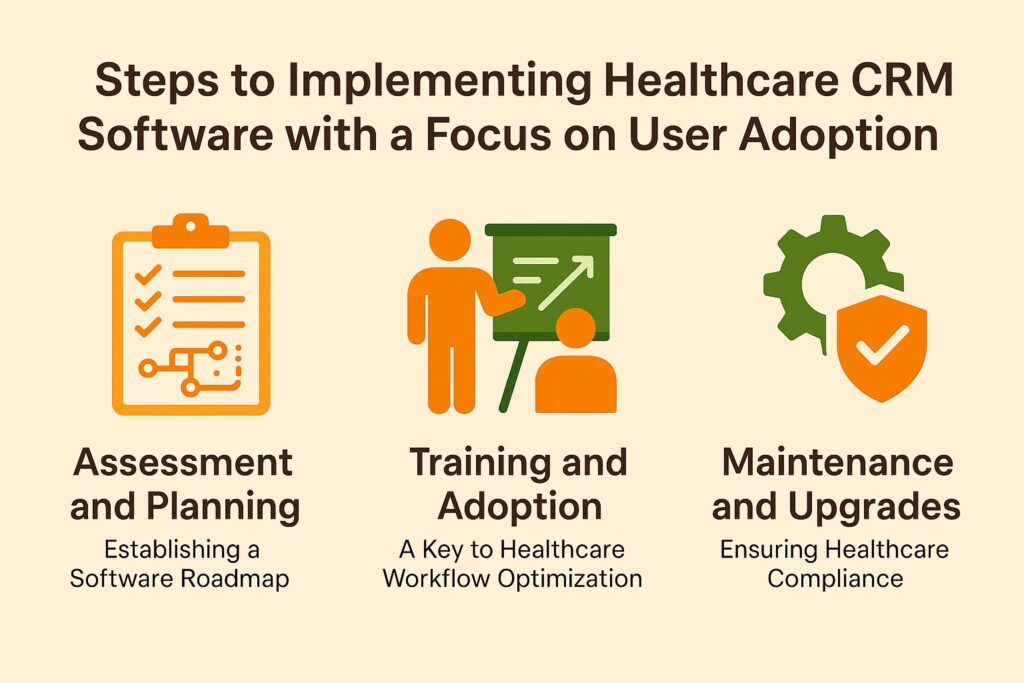
How Does Patient Intake Software Work?
In the rapidly changing field of healthcare, patient intake software Changes the way medical offices handle initial appointments with patients.
This technology streamlines the intake process, improves accuracy and speed, and reduces cumbersome paperwork.
By embracing electronic forms, appointment scheduling, and secure integrations with electronic health records, healthcare providers can greatly improve the patient experience.
This article explores the benefits, features, and operational mechanics of patient intake software and shows how it improves patient care and makes practice operations more efficient.
What Is Patient Intake Software?
Innovative healthcare technology, patient intake software simplifies the patient registration process and manages important patient information effectively, ensuring seamless software integration for better outcomes. By turning patient forms digital and connecting with electronic health records (EHR), this software digitizes patient forms and connects with electronic health records (EHR), speeding up workflows, reducing manual data entry, and facilitating patient integration into medical practices.

With features like online forms, solid data management, and patient self-service options, it helps healthcare providers concentrate on providing quality care while adhering to healthcare rules. It centers on staying within HIPAA rules and protecting data, which helps make talking with patients easier during their time with us and improves how we communicate and connect with them.
What Are the Benefits of Using Patient Intake Software?
Patient intake software provides many advantages that make work easier and make patients’ visits better.
This software manages tasks such as setting appointments and signing up patients, so healthcare workers can focus on providing good care instead of dealing with paperwork.
Features such as electronic forms and telehealth connections simplify the registration process, provide quick access to patient information, and promote patient involvement.
This leads to a more organized healthcare practice with better patient retention and satisfaction rates.
1. Streamlines the Intake Process
One main benefit of patient intake software is its efficiency in streamlining the intake process, greatly enhancing task automation. Healthcare providers make the process smoother from signing up patients to providing treatment by using online patient forms linked with electronic health records (EHR). This software cuts down on manual data entry and quickly collects key patient details, simplifying the process for patients.
Patients can fill out their forms before arriving, reducing wait times.
This change reduces staff workload, enabling them to spend more time caring for patients rather than managing paperwork.
The user-friendly design of the software simplifies data entry for healthcare workers, reducing the likelihood of mistakes and enhancing information accuracy.
As a result, overall practice productivity noticeably improves, and patient satisfaction increases due to faster service and a more organized method of care.
2. Improves Accuracy and Operational Efficiency
Using patient intake software improves the accuracy of data entry and makes healthcare operations more efficient. By utilizing electronic forms and software functionalities subject to data validation checks drastically reduces the risk of human error. This improvement makes patient records more accurate, improves clinical documentation, and helps doctors make better decisions with detailed reporting tools and data dashboards. As a result, healthcare providers can concentrate more on patient care instead of correcting data inconsistencies.
Patient intake software reduces errors and facilitates the collection of important details from patients before their appointments. By automating the collection of medical history, insurance details, and demographic data saves time and allows healthcare providers to prepare more thoroughly.
This process accelerates patient check-in and facilitates easy access to important information, resulting in a smoother experience and improved patient care coordination. Organizing data storage helps improve patient health by allowing practices to look at trends and change care plans when necessary, leading to better health results.
3. Reduces Paperwork and Manual Data Entry
Patient intake software reduces paperwork and minimizes the need for manual data entry by employing digital processes and online forms. By digitizing patient records, healthcare providers quickly find needed information, reducing administrative work and improving workflow efficiency. Switching from paper to digital forms enables healthcare teams to access patient information instantly, leading to quicker responses and better service.
Switching to digital methods simplifies processes and reduces mistakes that often occur with handwritten forms. Automated systems take care of routine tasks, allowing healthcare workers to focus on caring for patients rather than handling paperwork.
Easy data sharing between departments improves collaboration, leading to a more coordinated approach to patient care. Patient intake software gives healthcare facilities shorter waiting times and more satisfied patients, highlighting the many benefits of this technology.
4. Enhances Patient Experience
Patient intake software focuses on enhancing patient experience through an intuitive user interface and effective patient engagement strategies. By providing mobile access and user-friendly patient portals, this software enables patients to complete intake forms at their convenience, leading to higher patient satisfaction.
Feedback loops in the system help healthcare providers learn and improve the patient experience, creating a stronger connection between patients and their healthcare providers.
The simple design allows anyone to use it easily, no matter their technical ability.
Doctors and nurses keep patients informed and engaged in their treatment by providing personalized updates and using tools to monitor their progress.
Collecting and analyzing patient feedback allows practitioners to make data-driven improvements, addressing concerns before they become issues.
Real-time updates and notifications inform patients of any changes related to their appointments or treatment plans, enhancing their overall experience and trust in the healthcare system.
How Does Patient Intake Software Work?

Patient intake software enables patients to register online and collects important information through electronic forms. This begins with patients completing digital forms that include their medical history, personal details, and consent.
The system smoothly interacts with electronic health records (EHR) to arrange appointments and send notifications, offering healthcare providers the required details at the right time.
1. Online Registration
The online registration component of patient intake software enables efficient patient onboarding with intuitive online intake forms. Patients easily fill out their information from any device, ensuring data synchronization across the system. This feature reduces manual data entry and manages user permissions to keep data secure and protect patient privacy during registration.
The system speeds up the onboarding process, reducing wait times and improving patient satisfaction.

It enables healthcare providers to access patient records faster and with greater accuracy, resulting in better decisions.
Secure data handling methods protect confidential information from unauthorized access, and automatic alerts improve follow-up compliance.
These advantages enable healthcare facilities to allocate resources more effectively, improving operational efficiency and allowing staff to focus more on direct patient care.
2. Electronic Forms and Surveys
Electronic forms and surveys are important parts of patient intake software that collect and verify patient information accurately. These electronic forms can change using form templates to meet the specific needs of a practice and make sure that all required patient details are gathered quickly.
Being able to automatically handle form processing allows healthcare workers to concentrate on caring for patients instead of managing forms, which makes their work more efficient.
Electronic forms speed up the intake process and reduce mistakes that arise from manual data entry.
Creating validation rules in these forms makes sure that patient information is accurate and all necessary details are included before it goes to the administrative team.
This process saves time and keeps records consistent, enabling healthcare workers to find important information quickly.
This organized method of collecting information helps patients by offering personalized and quicker care.
3. Appointment Scheduling and Reminders
Patient intake software makes handling appointments easier and enhances patient follow-up through efficient scheduling and notifications.
Using various methods to set up automatic appointment alerts, healthcare providers decrease missed appointments and better communicate with patients.

This approach distributes resources better and improves workflow automation, enabling practices to operate more smoothly.
These systems typically send custom notifications via text messages, emails, or phone calls, so patients are reminded on time about their upcoming appointments.
Online scheduling allows patients to choose appointment times that fit their schedules, increasing their satisfaction and commitment.
Practices help patients stay accountable and make practice management better by clearly sharing information about appointments, including any changes or cancellations.
Effective scheduling and appointment reminder systems build strong connections between patients and healthcare providers, leading to better health outcomes and improved patient results.
4. Electronic Signature and Consent
Patient intake software helps healthcare providers manage patient consent in accordance with healthcare regulations through its electronic signature and consent feature.
Signing documents electronically improves patient privacy and makes consent management more efficient for practices.
This feature keeps HIPAA rules in check and protects important legal papers, making them simple to find.
Electronic signatures and consent forms reduce the time healthcare professionals spend on administrative tasks, allowing them to focus more on patient-centered care.
These solutions eliminate the need for physical paperwork, which often leads to misplaced forms or delays in processing.
Patients can now review and sign necessary papers from home, making registration easier for all involved.
This approach improves the patient experience and helps healthcare providers stay organized, leading to better care.
5. Integration with Electronic Health Records
Integration with electronic health records (EHR) allows smooth sharing and updating of health information, playing a key role in patient intake software.
This feature allows healthcare workers to access patient details collected at check-in easily, providing a complete view of the patient’s medical history.
Incorporating this system into clinical processes helps doctors make better choices, resulting in improved patient care.
Combining various types of information, such as demographics, medical history, allergies, and medication lists, speeds up processing and reduces errors from manual data entry, enhancing risk management.
This system helps healthcare workers quickly access patient details, enabling fast assessments and customized treatment plans.
EHR systems study data to find trends in patient health, helping to plan preventive measures and make care methods better.
Linking electronic health records improves healthcare systems and guarantees that patients receive personalized and effective care.
What Are the Features of Patient Intake Software?
Patient intake software makes daily tasks easier and keeps healthcare practices in line with HIPAA rules.
This software includes important features such as:
- Customizable forms and surveys to fit the needs of different practices
- Strong data security and privacy to keep patient information safe
- Tools for analytics and reporting that provide details on patient demographics and practice performance
- Steps to check insurance to make sure patients can use services
Patient tracking functions help manage patient interactions and follow-ups more effectively.

1. Customizable Forms and Surveys
Patient intake software allows healthcare providers to design forms and surveys that match their exact requirements for patient experience.
This feature improves form setup by enabling rapid creation of patient feedback surveys and pre-visit questionnaires, ensuring that healthcare providers gather important information quickly.
Modifying forms simplifies the process for patients to provide necessary information for quality care, enhancing the user experience.
These online tools help clinics collect important health details and motivate patients to take part in their own healthcare.
Simplified data gathering lets healthcare workers concentrate on providing quality care rather than handling paperwork.
Healthcare providers can adjust customizable forms to follow best practices and current healthcare standards, ensuring they meet requirements and are correct while creating a more responsive and patient-focused setting.
Consequently, this level of personalization improves health outcomes and strengthens relationships between patients and providers.
2. HIPAA Compliance
HIPAA compliance serves as a critical feature of patient intake software by safeguarding patient confidentiality and protecting sensitive health information. The software’s data security measures are designed to meet healthcare regulations and protect patient data from unauthorized access. Healthcare providers can follow regulations and simplify the intake procedure by using encryption, secure storage, and access controls.
Regular checks and staff education are important for keeping these standards, as they help everyone recognize the importance of safeguarding patient information.
The automatic removal of data after a set time, along with detailed records of access attempts, creates a secure environment.
These thorough measures meet legal requirements and build trust between patients and healthcare workers, allowing patients to share important details without worrying about privacy issues.
3. Data Security and Privacy
Patient intake software must prioritize protecting patient data. All patient information must be kept secure and handled with care. Focusing on secure data practices allows healthcare providers to exchange information safely and keep accurate records during patient care.
Healthcare organizations using these systems often improve their reputation significantly, as patients feel more secure sharing their private information.
Technologies like improved encryption methods, two-factor authentication, and regular security checks protect data, enhancing system performance.
Because of this, patients are more likely to communicate openly with their healthcare providers, which creates feelings of security and trust. The trust encourages patient loyalty and attracts new patients who value safe healthcare, improving the practice’s reputation in a competitive field.
4. Analytics and Reporting
Analytics and reporting tools in patient intake software give healthcare providers useful information about patients and performance data. By utilizing data analytics, practices can monitor trends in patient demographics, track appointment efficiency, and identify areas for improvement. This information helps make better decisions, simplify practice operations, and build stronger patient engagement strategies.
By analyzing patient data, healthcare providers can customize their services to meet individual patient needs better, leading to an improved overall patient experience.
For example, by examining wait times and appointment processes, healthcare workers can implement informed changes to improve efficiency, reduce patient frustration, and increase satisfaction rates.
Detailed reporting helps practices comply with industry rules and maintain clarity, building trust with patients and supporting compliance audits.
In healthcare, which depends greatly on information, these analyses are important for delivering high-quality care and supporting the growth of medical practices.
How Can Patient Intake Software Benefit Healthcare Providers?
Patient intake software greatly benefits healthcare providers by improving data management and analysis and reducing the time they spend on administrative work.
With more organized workflows and effective ways to interact with patients, providers can focus more on patient care rather than paperwork.
This efficiency is useful for scheduling appointments and tracking data capture, which increases overall effectiveness and productivity in clinical workflows and improves patient care.
1. Improved Data Management and Analysis
One of the key benefits of patient intake software is better data handling and review, which helps healthcare workers keep patient records correct and up-to-date. The software enables smooth information sharing between departments and improves data retrieval, aiding in better clinical decisions through thorough patient data analysis. This improvement simplifies workflows and raises the quality of care that healthcare providers deliver to patients.
Bringing different data sources together in one system helps healthcare workers quickly find important patient information, allowing for faster care and personalized treatment plans.
Strong healthcare analytics tools allow professionals to identify trends and potential health risks sooner, leading to proactive care instead of reacting after problems occur.
Improved data protection features keep sensitive information secure, increase data privacy, and help patients feel confident and engaged.
Good data management alters how patient care occurs, enabling providers to make choices that lead to better health results and happier patients over time while improving operational metrics.
2. Time and Cost Savings
One of the main benefits of patient intake software is that it saves healthcare providers time and money. Automating repetitive administrative tasks allows practices to significantly reduce the time spent on paperwork, which leads to improved resource allocation and cost efficiency. This enables healthcare teams to concentrate more on patient care and spend less time on paperwork, increasing the efficiency of the entire practice.
Software for patient registration cuts down on wait times and quickly captures essential details. When healthcare workers spend more time with patients instead of on paperwork while using patient management systems, patient connections improve, leading to greater satisfaction.
This technology, which includes medical billing and software features, reduces operational costs and improves healthcare teams’ ability to address various patient needs more effectively.
3. Better Patient Engagement and Satisfaction
Patient intake software improves patient engagement and satisfaction by making communication easier and using effective follow-up methods. By providing patients with easy-to-use online portals and notifications for their appointments, healthcare providers improve their relationships and make patients feel appreciated during their treatment. The software simplifies retrieving important health information and facilitates informed choices, improving the patient experience.
With features like secure messaging, custom health plans, and effective data gathering, healthcare workers adjust their methods to suit each patient’s needs. This clear way of talking addresses concerns and allows patients to take charge, encouraging their active participation in their healthcare.
As a result, a more engaged patient likely maintains a positive outlook on their treatment and follows through with recommended health strategies, significantly improving overall outcomes in chronic disease management.
4. Enhanced Workflow and Productivity
Software for patient intake in healthcare streamlines tasks and improves staff productivity. Using technology to manage administrative tasks and improve clinical procedures greatly increases healthcare providers’ productivity. Managing tasks effectively allows staff to concentrate on providing excellent patient care instead of getting lost in paperwork, which benefits the entire practice.
Organizing appointments, handling patient files, and smoothly processing billing with integration capabilities creates considerable time savings.
Spending less time on routine tasks allows healthcare workers to focus more on patient care and improve the overall patient experience.
Reduce errors and improve team communication by using shared standards, creating a more collaborative environment that improves patient care.
In the end, using automation in healthcare, with support from EHR systems and cloud computing, helps doctors and results in better health outcomes and more satisfied patients.
Featured Patient Intake Software Providers
| Software Provider | Best For | Why It Stands Out |
|---|---|---|
| Phreesia | Larger practices needing robust customization | Offers check-in kiosks, real-time insurance validation, and integrated digital payments. |
| RXNT | Practices seeking an all-in-one software suite | Provides digital intake built into a comprehensive EHR and Practice Management platform. |
| NexHealth | Practices wanting end-to-end patient engagement | Combines intake forms, online scheduling, appointment reminders, and patient reviews. |
| Kareo | Independent practices | Budget-friendly, user-friendly, and integrates seamlessly with Kareo’s EHR and billing tools. |
| SimplePractice | Behavioral health and solo providers | Offers a streamlined, HIPAA-compliant interface with remote-friendly digital intake forms. |
Frequently Asked Questions
What is patient intake software and how does it work with software customization?
Patient intake software is a digital tool that simplifies the process of gathering patient details and forms during check-in. It allows patients to fill out forms and provide personal information electronically, which securely stores and easily provides access for healthcare providers.
How does patient intake software improve the patient experience?
Patient intake software removes the need for paper forms and reduces wait times, making check-in quicker and easier for patients. It cuts down on mistakes and collects accurate data, making things easier and more comfortable for patients.
Can healthcare providers customize the patient intake software to fit their specific needs?
Yes, healthcare providers can tailor patient intake software to fit their specific needs. This includes adding custom forms, questionnaires, and patient information fields to gather necessary data for each individual practice.
How does patient intake software protect patient data and keep it private?
Patient intake software employs advanced encryption and security measures that protect patient data from unauthorized access. It follows HIPAA rules and protects the privacy and confidentiality of patient information.
Is patient intake software easy to use for both patients and healthcare providers?
Developers design patient intake software to be user-friendly, simple, and intuitive for both patients and healthcare providers. The simple design and features make the check-in process fast and easy for everyone.
What kind of patient information can be collected and stored using intake software?
Patient intake software collects and stores a wide range of information, including personal details, medical history, insurance information, and consent forms. Healthcare providers can customize the specific information collected to fit their needs.
Related Resources:


